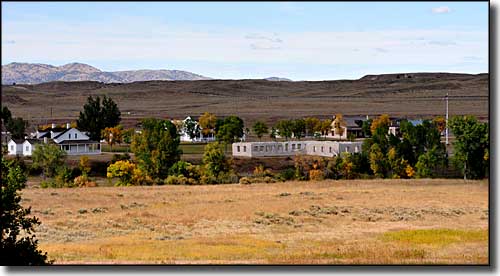
The Grattan Massacre

Fort Laramie from a distance
The Grattan "Massacre" was an event that happened near Fort Laramie in August, 1854. In accordance with the terms of the 1851 Treaty, about 4,000 members of the Brulé and Oglala Sioux were camped near Fort Laramie. A Minneconjou named High Forehead killed a cow belonging to a Mormon traveling on the nearby Mormon Trail. The matter was brought up to the commanding officer of Fort Laramie: Lt. Hugh Fleming. According to the terms of the 1851 Treaty, the matter should have been dealt with by the local appointed Indian agent (John Whitfield, who was due to arrive a couple days later) and the military should never have been involved. However, Lt. Fleming had a conversation with Chief Conquering Bear in regards to the dead cow. The chief offered the cow's owner any choice of any of his 60-head herd of horses. The cow's owner refused and demanded $25 instead. At that point, Lt. Fleming insisted that Conquering Bear arrest High Forehad and turn him over to military authorities. Conquering Bear refused.
The next day Second Lieutenant John Lawrence Grattan led a detachment of troops into the Sioux camp to retrieve the cow-murdering Lakota. As a recent graduate of West Point, Grattan was looking to prove his mettle, although he was inexperienced, short-tempered and openly insulting of the Sioux's abilities as warriors. As a result, this was to be his first, last and only experience of the Sioux as warriors. "There is no doubt that Lt. Grattan left this post with a desire to have a fight with the Indians, and that he had determined to take the man at all hazards," is how another commander at Fort Laramie later recalled it. Grattan was accompanied by 27 privates, 1 corporal and 1 sergeant. He also took along an "interpreter," one Lucienne Auguste, a French-American ne'er-do-well who could hardly speak broken Dakota, never mind any of the other Sioux dialects. It didn't help that Auguste was drunk by the time the detachment neared the Sioux camp.
As the soldiers entered the camp, the "interpreter" started taunting and insulting the Sioux by calling their warriors women and stating that the soldiers were there to kill them, not talk to them. There was another trader named James Bordeau present in the Sioux camp (and carrying on peaceful trading activities) at the time and he was a witness to some of the following events. Bordeau was aware that the soldiers were in the camp and was eventually called in by the Sioux because they trusted him, and he spoke impeccable Lakota.
As much as Conquering Bear was well apprised of the situation (legalities and all) and tried to defuse it by negotiating with Grattan, Grattan refused all talk and simply escalated the tensions with his demands that the Sioux arrest and turn over High Forehead. When Bordeau was called in to assist he later said the situation was out of hand already and the Sioux warriors were taking up flanking positions around the soldiers. At that point, Bordeau turned around and returned to his own camp, telling his fellow traders to arm themselves and get ready for a fight.
About that time Lt. Grattan realized that he and his troops were in a bad position so he stopped his "negotiations" and returned to his horse. Seeing that this was going nowhere, Conquering Bear stood up and was immediately shot in the back by one of the soldiers. Then another soldier starting shooting into a group of warriors standing nearby. The shooting was over in minutes with the entire detachment and the "interpreter" wiped out. The Sioux suffered one dead (Conquering Bear) and one wounded.
As much as the military was completely in the wrong and had actually instigated this situation in which they never should have been involved, the American press used the event to stir up anti-Indian sentiments. And, of course, Washington and the War Department played into it. William S. Harney was sent to Fort Kearny in Nebraska to assume command of the 2nd US Dragoons. The Dragoons then met up with a group of Brulé Sioux at Ash Hollow (also known as Bluewater Creek) in Garden County, Nebraska and killed a number of of the Sioux in retaliation.
